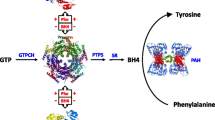Abstract
The interdependence of the predicted in vitro residual enzyme activity (PRA), as deduced from the complete genotypes of 64 hyperphenylalaninaemic patients, and parameters for diagnosis of hyperphenylalaninaemic disorders, the fluctuation of the phyenlylalanine (Phe) values during treatment, long-term dietary control during treatment, and a parameter for the outcome of therapy (IQ) was investigated by correlation analysis. A highly significant correlation was found between the PRA and diagnostic parameters, as well as the fluctuation of the Phe values during treatment. Significant correlations were also observed between the parameter describing the fluctuation of the Phe values and the IQ, as well as between the quality of dietary control and IQ. The PRA is a valuable tool for the differential diagnosis of hyperphenylalaninaemic disorders and for the prediction of one aspect of the course of the disease which is related to the intellectual outcome of therapy. The quality of dietary control was independent of the genotype, indicating that the outcome of therapy can be successfully manipulated in spite of the genetic make-up.
Similar content being viewed by others
Abbreviations
- 72h Phe :
-
phe level 72h after protein loading
- MYM :
-
mean year median
- PAH :
-
phenylalanine hydroxylase
- Phe :
-
phenylalanine
- PKU :
-
phenylketonuria
- PRA :
-
predicted in vitro residual enzyme activity
- SEE :
-
standard error of estimate
- WISC-R :
-
Wechsler Intelligence Scale for Children-Revised
References
Apold J, Eiken HG, Svensson E, Kunert E, Kozak L, Cechak P, Güttler F, Giltay J, Lichter-Konecki U, Melle D, Jaruzelska JM, Woo SLC (1993) The phenylketonuria G272X/haplotype 7 mutation in European populations. Hum Genet 92:107–109
Dasovich M, Konecki D, Lichter-Konecki U, Eisensmith RC, Güttler F, Naughton E, Mulline C, Woo SLC (1991) Molecular characterization of PKU allele prevalent in Southern Europe and Ireland. Somatic Cell Mol Genet 17:303–309
Dworniczak B, Aulehla-Scholz C, Kalaydjieva L, Bartholomé K, Grudda K, Horst J (1991) Aberrant splicing of phenylalanine hydroxylase mRNA: the major cause for phenylketonuria in parts of southern Europe. Genomics 11: 242–246
Eisensmith RC, Woo SLC (1992) Molecular basis of phenylketonuria and related hyperphenylalaninemias: mutations and polymorphisms in the human phenylalanine hydroxylase gene. Hum Mutation 1:13–23
Kaufman S (1976) Phenylketonuria: biochemical mechanisms. Adv Neurochem 2:1–132
Konecki DS, Schweitzer-Krantz S, Byrd D, Trefz FK, Lichter-Konecki U (1993) Facilitation of hyperphenylalaninaemia phenotype assessment by genotype analysis. Eur J Pediatr 152: 1048–1049
Lichter-Konecki U, Konecki DS, DiLella AG, Brayton K, Marvit J, Hahn T, Trefz FK, Woo SLC (1988) Phenylalanine hydroxylase deficiency caused by a single base substitution in the human phenylalanine hydroxylase (PAH) gene. Biochemsitry 27:2881–2885
Lichter-Konecki U, Rupp A, Konecki DS, Trefz FK, Schmidt H, Burgard P (1994) Relation between phenylalanine hydroxylase genotypes and phenotypic parameters of diagnosis and treatment of hyperphenylalaninaemic disorders. J Inherited Metab Dis 17:362–365
Lutz P, Schmidt H, Batzler U (1990) Study design and description of patients. Eur J Pediatr 149[Suppl 1]:5–12
Okano Y, Eisensmith RC, Güttler F, Lichter-Konecki U, Konecki DS, Trefz FK, Dasovich M, Wang T, Henriksen K, Lou H, Woo SLC (1991) Molecular basis of phenotypic heterogeneity in phenylketonuria. N Engl J Med 324:1232–1238
Olkin J (1967) Correlations revisited: In: Stanley JC (ed) Improving experimental design and statistical analysis. Rand McNally, Chicago pp 102–128
Rupp A, Burgard P (1995) The comparison of different indices of dietary control in phenylketonuria. Acta Paediatr 84:521–527
Svensson E, Döbeln U von, Eisensmith RC, Hagenfeldt L, Woo SLC (1993) Relation between genotype and phenotype in Swedish phenylketonuria and hyperphenylalaninemia patients. Eur J Pediatr 152:132–139
Trefz FK, Burgard P, König T, Goebel-Schreiner B, Lichter-Konecki U, Konecki D, Schmidt E, Schmidt H, Bickel H (1993) Genotype-phenotype correlations in phenylketonuria. Clin Chim Acta 217:15–21
Woo SLC, Lidsky AS, Guttler F, Chandra T, Robson KJH (1983) Cloned human phenylalanine hydroxylase gene allows prenatal detection of classical phenylketonuria. Nature 306:151–155
Author information
Authors and Affiliations
Rights and permissions
About this article
Cite this article
Burgard, P., Rupp, A., Konecki, D.S. et al. Phenylalanine hydroxylase genotypes, predicted residual enzyme activity and phenotypic parameters of diagnosis and treatment of phenylketonuria. Eur J Pediatr 155 (Suppl 1), S11–S15 (1996). https://doi.org/10.1007/PL00014222
Issue Date:
DOI: https://doi.org/10.1007/PL00014222




